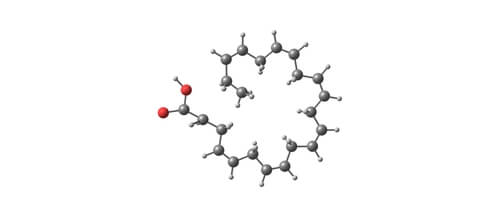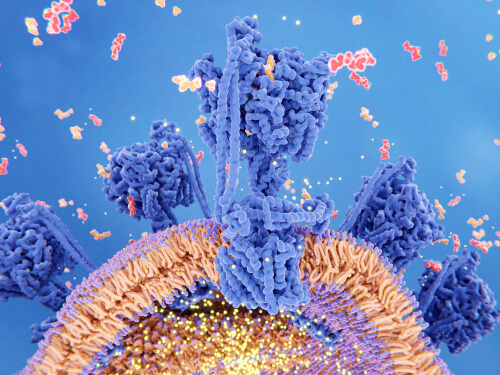What Are Fatty Acids?

Fatty acids are the basic units of saponifiable lipids, that is, they’re molecules formed by a long chain of between 4 and 24 carbons. At the end of this chain is a carbon atom that makes up a carboxylic group, also known as an acid group. In chemistry, it’s represented by this formula: –COOH.
Each carbon atom is attached to the next and the preceding one by means of a single or double covalent bond. The atom at its end has three free bonds that are occupied by hydrogen atoms. In this way, the extreme carbon that isn’t formed by the acid group is represented as follows: H3C-.
Fatty acids are part of the phospholipids and glycolipids, molecules that make up the lipid bilayer of all cell membranes. In this way, they’re essential structures for its formation and for the survival of cells. They’re stored in adipose tissue.
In mammals, including humans, most fatty acids are in the form of triglycerides. In these molecules, the carboxylic ends of three acids are esterified, that is, they react with each of the hydroxyl groups (-OH) of glycerol or glycerin.
Classification

Fatty acids can be classified into two large groups, according to the double bonds they contain in their chain: saturated and unsaturated.
Saturated fatty acids
As for this group, all the covalent bonds present in its chemical structure are single bonds. Because of this, the fatty acid chains are linear. In addition, this characteristic makes them solid at room temperature.
Saturated fatty acids are found in animal fats and in coconut, palm, and peanut oils. Some examples of them are:
- Palmitic
- Stearic
- Myristic
Unsaturated fatty acids
On the other hand, unsaturated fatty acids have more than one double covalent bond in their chain. The distance between the carbon atoms isn’t the same as with the others. The same goes for bond angles.
In this way, the unsaturated ones have connections with changes of direction in the places where a double bond appears between carbon atoms.
As a consequence of the presence of these types of bonds, they’re in a liquid state at room temperature, since they have a lower melting point. The melting point is the temperature at which a substance changes from a solid to a liquid state.
Unsaturated fatty acids can be found in vegetable oils and oily fish oils. For example, oleic acid is a monounsaturated fatty acid, that is, it only contains one double bond in its chain. Among the most important polyunsaturated fatty acids, we find:
- Linoleic: contains two double bonds, also called unsaturations.
- Linolenic: it has 3 instaurations.
- Arachidonic acid: with 4 double bonds in its chain.
What are fatty acids for?
Among the functions of these molecules, we can mention the following:
- Energy function: they’re very high in calories, and necessary molecules in all cellular processes in the presence of oxygen. In addition, when the insulin level is very low or there isn’t enough glucose available to use it as an energy source in cellular processes, the body burns fatty acids for this purpose.
When the body uses fatty acids for energy, ketone bodies are formed, waste products that cause an excessive rise in acid in the blood. This could lead to ketoacidosis, a major problem.
- Structural function: as we have already mentioned, fatty acids are basic components of phospholipids and sphingolipids, molecules that form the lipid bilayer of the membranes of all cells.
- Regulatory function: some of these molecules are precursors of prostaglandins, thromboxanes and leukotrienes, which have great biological activity. They’re involved in the regulation and control of many vital processes, such as the inflammatory response, regulation of body temperature, blood clotting processes, etc.
You may be interested in: What Is Hemophilia?

Cardiovascular diseases related to its consumption
Food is an important source of fatty acids. This contribution is extremely important to maintain a stable level of lipids and to supply the body with essential ones, which are polyunsaturated with double bonds in the cis position.
Fatty acids considered essential include omega-3 and omega-6. The human body can’t synthesize them, so we must regulate their levels through food.
Another great article: When to Take Vitamin Supplements?
Numerous studies have shown that having too many of these molecules could have important consequences for health, especially the saturated and unsaturated trans. Notably, the increased risk of cardiovascular problems stands out.
Due to this, the consumption of cis polyunsaturated fatty acids (linolenic and linoleic) is recommended, avoiding as much as possible the consumption of saturated and unsaturated trans fats.
Fatty acids are the basic units of saponifiable lipids, that is, they’re molecules formed by a long chain of between 4 and 24 carbons. At the end of this chain is a carbon atom that makes up a carboxylic group, also known as an acid group. In chemistry, it’s represented by this formula: –COOH.
Each carbon atom is attached to the next and the preceding one by means of a single or double covalent bond. The atom at its end has three free bonds that are occupied by hydrogen atoms. In this way, the extreme carbon that isn’t formed by the acid group is represented as follows: H3C-.
Fatty acids are part of the phospholipids and glycolipids, molecules that make up the lipid bilayer of all cell membranes. In this way, they’re essential structures for its formation and for the survival of cells. They’re stored in adipose tissue.
In mammals, including humans, most fatty acids are in the form of triglycerides. In these molecules, the carboxylic ends of three acids are esterified, that is, they react with each of the hydroxyl groups (-OH) of glycerol or glycerin.
Classification

Fatty acids can be classified into two large groups, according to the double bonds they contain in their chain: saturated and unsaturated.
Saturated fatty acids
As for this group, all the covalent bonds present in its chemical structure are single bonds. Because of this, the fatty acid chains are linear. In addition, this characteristic makes them solid at room temperature.
Saturated fatty acids are found in animal fats and in coconut, palm, and peanut oils. Some examples of them are:
- Palmitic
- Stearic
- Myristic
Unsaturated fatty acids
On the other hand, unsaturated fatty acids have more than one double covalent bond in their chain. The distance between the carbon atoms isn’t the same as with the others. The same goes for bond angles.
In this way, the unsaturated ones have connections with changes of direction in the places where a double bond appears between carbon atoms.
As a consequence of the presence of these types of bonds, they’re in a liquid state at room temperature, since they have a lower melting point. The melting point is the temperature at which a substance changes from a solid to a liquid state.
Unsaturated fatty acids can be found in vegetable oils and oily fish oils. For example, oleic acid is a monounsaturated fatty acid, that is, it only contains one double bond in its chain. Among the most important polyunsaturated fatty acids, we find:
- Linoleic: contains two double bonds, also called unsaturations.
- Linolenic: it has 3 instaurations.
- Arachidonic acid: with 4 double bonds in its chain.
What are fatty acids for?
Among the functions of these molecules, we can mention the following:
- Energy function: they’re very high in calories, and necessary molecules in all cellular processes in the presence of oxygen. In addition, when the insulin level is very low or there isn’t enough glucose available to use it as an energy source in cellular processes, the body burns fatty acids for this purpose.
When the body uses fatty acids for energy, ketone bodies are formed, waste products that cause an excessive rise in acid in the blood. This could lead to ketoacidosis, a major problem.
- Structural function: as we have already mentioned, fatty acids are basic components of phospholipids and sphingolipids, molecules that form the lipid bilayer of the membranes of all cells.
- Regulatory function: some of these molecules are precursors of prostaglandins, thromboxanes and leukotrienes, which have great biological activity. They’re involved in the regulation and control of many vital processes, such as the inflammatory response, regulation of body temperature, blood clotting processes, etc.
You may be interested in: What Is Hemophilia?

Cardiovascular diseases related to its consumption
Food is an important source of fatty acids. This contribution is extremely important to maintain a stable level of lipids and to supply the body with essential ones, which are polyunsaturated with double bonds in the cis position.
Fatty acids considered essential include omega-3 and omega-6. The human body can’t synthesize them, so we must regulate their levels through food.
Another great article: When to Take Vitamin Supplements?
Numerous studies have shown that having too many of these molecules could have important consequences for health, especially the saturated and unsaturated trans. Notably, the increased risk of cardiovascular problems stands out.
Due to this, the consumption of cis polyunsaturated fatty acids (linolenic and linoleic) is recommended, avoiding as much as possible the consumption of saturated and unsaturated trans fats.
- FAO. (2010). Grasas y ácidos grasos en nutrición humana Consulta de expertos. Estudio FAO alimentación y nutrición. https://doi.org/978-92-5-3067336
- Fernández-Michel, S. G ; García-Díaz C. L ; Alanís-Guzmán, M. G ; Ramos-Clamont, M. G. (2008). Ácidos Grasos. Ciencia Y Tecnología Alimentaria.
- Nutrición, S. M. De. (2008). Ácidos Grasos. Ciencia Y Tecnología Alimentaria.
Este texto se ofrece únicamente con propósitos informativos y no reemplaza la consulta con un profesional. Ante dudas, consulta a tu especialista.







